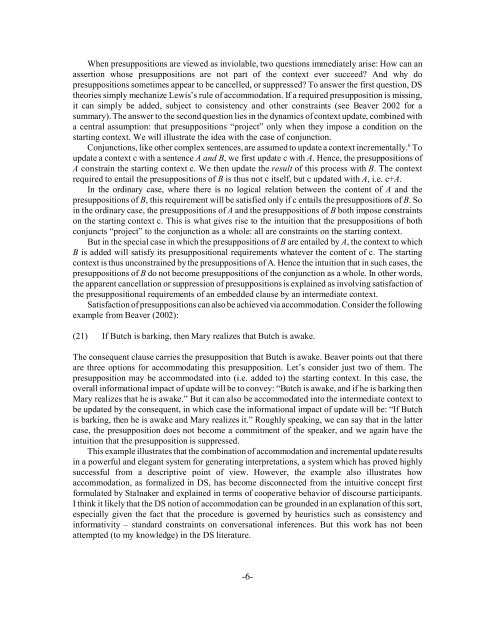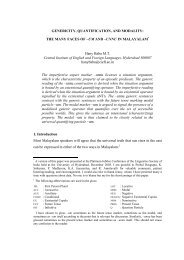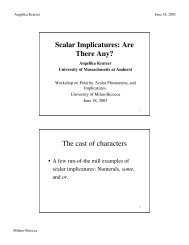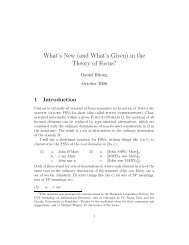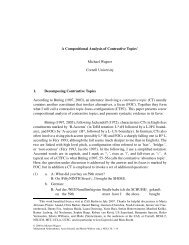Foundational Issues in Presupposition - New York University
Foundational Issues in Presupposition - New York University
Foundational Issues in Presupposition - New York University
You also want an ePaper? Increase the reach of your titles
YUMPU automatically turns print PDFs into web optimized ePapers that Google loves.
When presuppositions are viewed as <strong>in</strong>violable, two questions immediately arise: How can an<br />
assertion whose presuppositions are not part of the context ever succeed? And why do<br />
presuppositions sometimes appear to be cancelled, or suppressed? To answer the first question, DS<br />
theories simply mechanize Lewis’s rule of accommodation. If a required presupposition is miss<strong>in</strong>g,<br />
it can simply be added, subject to consistency and other constra<strong>in</strong>ts (see Beaver 2002 for a<br />
summary). The answer to the second question lies <strong>in</strong> the dynamics of context update, comb<strong>in</strong>ed with<br />
a central assumption: that presuppositions “project” only when they impose a condition on the<br />
start<strong>in</strong>g context. We will illustrate the idea with the case of conjunction.<br />
Conjunctions, like other complex sentences, are assumed to update a context <strong>in</strong>crementally. 6 To<br />
update a context c with a sentence A and B, we first update c with A. Hence, the presuppositions of<br />
A constra<strong>in</strong> the start<strong>in</strong>g context c. We then update the result of this process with B. The context<br />
required to entail the presuppositions of B is thus not c itself, but c updated with A, i.e. c+A.<br />
In the ord<strong>in</strong>ary case, where there is no logical relation between the content of A and the<br />
presuppositions of B, this requirement will be satisfied only if c entails the presuppositions of B. So<br />
<strong>in</strong> the ord<strong>in</strong>ary case, the presuppositions of A and the presuppositions of B both impose constra<strong>in</strong>ts<br />
on the start<strong>in</strong>g context c. This is what gives rise to the <strong>in</strong>tuition that the presuppositions of both<br />
conjuncts “project” to the conjunction as a whole: all are constra<strong>in</strong>ts on the start<strong>in</strong>g context.<br />
But <strong>in</strong> the special case <strong>in</strong> which the presuppositions of B are entailed by A, the context to which<br />
B is added will satisfy its presuppositional requirements whatever the content of c. The start<strong>in</strong>g<br />
context is thus unconstra<strong>in</strong>ed by the presuppositions of A. Hence the <strong>in</strong>tuition that <strong>in</strong> such cases, the<br />
presuppositions of B do not become presuppositions of the conjunction as a whole. In other words,<br />
the apparent cancellation or suppression of presuppositions is expla<strong>in</strong>ed as <strong>in</strong>volv<strong>in</strong>g satisfaction of<br />
the presuppositional requirements of an embedded clause by an <strong>in</strong>termediate context.<br />
Satisfaction of presuppositions can also be achieved via accommodation. Consider the follow<strong>in</strong>g<br />
example from Beaver (2002):<br />
(21) If Butch is bark<strong>in</strong>g, then Mary realizes that Butch is awake.<br />
The consequent clause carries the presupposition that Butch is awake. Beaver po<strong>in</strong>ts out that there<br />
are three options for accommodat<strong>in</strong>g this presupposition. Let’s consider just two of them. The<br />
presupposition may be accommodated <strong>in</strong>to (i.e. added to) the start<strong>in</strong>g context. In this case, the<br />
overall <strong>in</strong>formational impact of update will be to convey: “Butch is awake, and if he is bark<strong>in</strong>g then<br />
Mary realizes that he is awake.” But it can also be accommodated <strong>in</strong>to the <strong>in</strong>termediate context to<br />
be updated by the consequent, <strong>in</strong> which case the <strong>in</strong>formational impact of update will be: “If Butch<br />
is bark<strong>in</strong>g, then he is awake and Mary realizes it.” Roughly speak<strong>in</strong>g, we can say that <strong>in</strong> the latter<br />
case, the presupposition does not become a commitment of the speaker, and we aga<strong>in</strong> have the<br />
<strong>in</strong>tuition that the presupposition is suppressed.<br />
This example illustrates that the comb<strong>in</strong>ation of accommodation and <strong>in</strong>cremental update results<br />
<strong>in</strong> a powerful and elegant system for generat<strong>in</strong>g <strong>in</strong>terpretations, a system which has proved highly<br />
successful from a descriptive po<strong>in</strong>t of view. However, the example also illustrates how<br />
accommodation, as formalized <strong>in</strong> DS, has become disconnected from the <strong>in</strong>tuitive concept first<br />
formulated by Stalnaker and expla<strong>in</strong>ed <strong>in</strong> terms of cooperative behavior of discourse participants.<br />
I th<strong>in</strong>k it likely that the DS notion of accommodation can be grounded <strong>in</strong> an explanation of this sort,<br />
especially given the fact that the procedure is governed by heuristics such as consistency and<br />
<strong>in</strong>formativity – standard constra<strong>in</strong>ts on conversational <strong>in</strong>ferences. But this work has not been<br />
attempted (to my knowledge) <strong>in</strong> the DS literature.<br />
-6-


